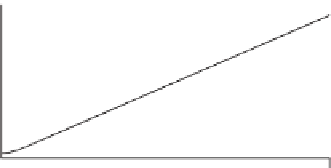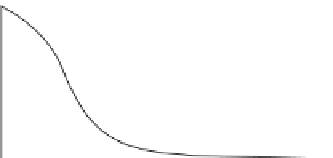Geoscience Reference
In-Depth Information
Figure 5.17
(a) The increase of
encounter rates between larval cod and
copepod nauplii as turbulence
increases. (b) The reduction in the
success of larvae catching nauplii as
turbulence increases. (c) The net effect
of turbulence on successful larva-
nauplii encounters resulting from
combining (a) and (b). From
Mackenzie et al.,
1994
, with
permission from ASLO.
Equivalent wind speed (m s
-1
)
0
21.8
43.6
65.4
87.2
(a)
30
20
10
0
5
10
15
20
(b)
1.0
0.5
0.0
0
5
10
15
20
(c)
4
3
2
1
0
0
5
10
15
20
Turbulent velocity (mm s
-1
)
Box 5.3 Recycling fish
We tend to view the transfer of organic material through the heterotrophs as a
progression of small organisms being eaten by larger organisms, which are in turn
eaten by yet larger animals. An interesting observation during a research cruise in
the Celtic Sea in summer 2008 illustrates a contrast in the flow of organic matter.
PhD student In˜ igo Martinez carried out several deployments of a near-bed camera
to capture images of fish in the region. The camera was suspended above a weight
baited with four mackerel, and took a picture every 1 minute during a deployment
that typically lasted for 24 hours. Initial images from the first two deployments
were obscured by suspended sediments, caused by the tidal flow, but when the
water cleared the images showed that all that was left of the bait were four clean
skeletons. Eventuality In˜ igo managed to capture images of the culprits: within half
an hour of deployment a swarm of isopods (the marine equivalent of woodlice)
would find the bait and pick it completely clean within 2 hours. The image below







































Search WWH ::

Custom Search